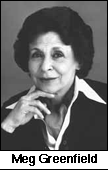


 On July 17, 2001, the former publisher of the Washington Post, Katharine Graham (1917-2001), died. It suddenly dawned on me that I could divide my life in a pre- and post-Katharine Graham eras. In early 1985, she came through Lima on one of her infamous overseas tours -- Brazil, Peru and Argentina. She was accompanied by Meg Greenfield, the editorial page editor and her close friend, as well as Jim Hoagland, the foreign news editor, who bailed out of the tour after Brazil because an international crisis demanded his attention. Jackson Diehl, the Post's South American bureau chief, had to herd the group through the course.
On July 17, 2001, the former publisher of the Washington Post, Katharine Graham (1917-2001), died. It suddenly dawned on me that I could divide my life in a pre- and post-Katharine Graham eras. In early 1985, she came through Lima on one of her infamous overseas tours -- Brazil, Peru and Argentina. She was accompanied by Meg Greenfield, the editorial page editor and her close friend, as well as Jim Hoagland, the foreign news editor, who bailed out of the tour after Brazil because an international crisis demanded his attention. Jackson Diehl, the Post's South American bureau chief, had to herd the group through the course.
I was in charge of putting together her seven-day itinerary in the country. Her yearly outings abroad were famous within the Washington Post organization because they required striking a delicate balance between anticipating her every need without seeming to pamper her. For instance, Diehl's most challenging test was making sure that Mrs. Graham had an adequate hairdresser in every capital. Jackson probably did not know the difference between a hair curler and branding iron. The stakes were high: a Newsweek bureau chief in Africa lost his job following a Graham tour.
A Newsweek editor told me, "Mike, you can spend any amount of money you think necessary to make this trip come off."
From my perspective, it was a unique situation: I was told to explain Peru, its circumstances and stakes, using whatever means I could obtain, no matter the budget or the bother. I could call on any public figure or expert -- from President Fernando Belaunde to soup kitchen organizers. I was slightly limited by the need to keep most interviews in English. I had to set up the schedule and outings, prep the interviewees if necessary, hire the limousine and van, coordinate our larger gatherings and lots of other details.
The interviews and sessions that I lined up show how I could accomplish this:
Graham was nothing what you might have expected. She was shrewd, inquisitive and tough. She took her journalism role seriously. She caught all our guests and interviewees by surprise because they were expecting a figurehead publisher from an elite power family. Instead, she asked tough questions and could spell B.S. a mile away.
My biggest perk of the trip was having a stretch limousine pick me up each morning from my home.
President Belaunde offered to fly Mrs. Graham and her entourage from the city of Cusco to Machu Picchu in an Air Force helicopter (the only helicopters in the country) because we were only going to be in Cusco one day and would miss that morning's tourist train to the Inca ruins. "You can't visit Peru without seeing Machu Picchu," Belaunde had said. When Mrs. Graham found out, however, that the rental of a helicopter would have costed a fortune, she decided that she could not accept the offer because it would compromise her journalistic independence.
In the end, Lima Tours pulled strings and got a powered rail car contracted exclusively for our party to go to Machu Picchu, leaving once we had arrived from Lima. We came back that same afternoon, spent the evening in Cusco and then returned to Lima the next morning.
 We all survived the experience (Graham was 70 years old at the time). Post and Newsweek editors then paid more attention to my story ideas -- though having Alan Garcia and Sendero as running stories in Peru didn't hurt. Meg Greenfield was a reference for a MacArthur Foundation Writing Grant application in 1987.
We all survived the experience (Graham was 70 years old at the time). Post and Newsweek editors then paid more attention to my story ideas -- though having Alan Garcia and Sendero as running stories in Peru didn't hurt. Meg Greenfield was a reference for a MacArthur Foundation Writing Grant application in 1987.
Meg Greenfield died about a year before K. Graham did. Jackson is now the op-ed page editor.
Actually, I had been lucky: first, the Brazil stretch of the trip had slipped into the control of a social power broker who steered the meetings toward Brazil's "rich and famous," which riled Mrs. Graham who hated to deal with frivolous people. Second, by the time the group reached the third leg of the trip, Argentina, the party was so tired that they just wanted to get home. So Peru ended up being the high point of the trip.
For the next five years, I lived off the professional and creative energy that the encounter generated. I also benefited from the exceptional Post and Newsweek correspondents who rotated throught the South America bureaus. I always had support and encouragement from them. Looking back, I probably could have parlayed this success into something with the Post-Newsweek organization but I was too clueless at the time to know what that might have been or how I would have accomplished it.